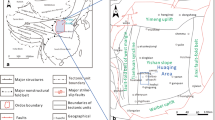Tight oil reservoirs are characterized by low porosity, low permeability, small seepage channels (micro-nano-scale pore development), and low pressure coefficient. The existing development technology can not solve the problems of low output, fast decline, difficulty in replenishing energy, and low recovery ratio. In this paper, the T2 spectrum of saturated oil samples is detected by NMR analyzer, and the spontaneous imbibition and pressurized imbibition experiments are carried out with deuterium water. By scanning the T2 spectrum of nuclear magnetic resonance, the peak value of T2 spectrum decreases with the imbibition process, which indicates that the oil in the core is gradually imbibed, and the change trend of spontaneous imbibition quality is basically consistent with that of the spectral area. The experimental results show that the effects of soaking wells on the oil recovery of different wells are obviously different. There are many factors that affect the effect of well soaking, including porosity, permeability, mineral composition, and so on, which together affect the final effect of the well soaking. From the experimental results, the clay minerals in the core, especially the illite-montmorillonite mixed layer, have an obvious influence on the imbibition rate. The higher the content of the illite-montmorillonite mixed layer, the faster the imbibition rate. This study is of great significance for the development of the tight oil.

Similar content being viewed by others
References
G. Xu, “Characteristics and influencing factors for forced imbibition in tight sandstone based on low-field nuclear magnetic resonance measurements,” Energy Fuels, 32(8), 8230-8240 (2018).
D. C. Standnes, “Experimental study of the impact of boundary conditions on oil recovery by co-current and counter-current spontaneous inhibition,” Energy Fuels, 18(1), 271-282 (2004).
G. Mason, “Spontaneous counter-current imbibition into core samples with all faces open,” Transp. Porous Media, 78(2), 199-216 (2009).
H. Fischer, “Modeling the effect of viscosity ratio on spontaneous imbibition,” SPE Res. Eval. Eng., 11(3), 577-589 (2008).
G. Mason, “Correlation for the effect of fluid viscosities on counter-current spontaneous imbibition,” J. Pet. Sci. Eng., 72(1-2), 195-205 (2010).
A. Al-Ameri, “Effect of injection pressure on the imbibition relative permeability and capillary pressure curves of shale gas matrix,” Petrophysics, 61(2), 218-229 (2020).
Y. Liu, “A new classification system of lithic-rich tight sandstone and its application to diagnosis high-quality reservoirs,” Adv. Geo Energy Res., 4, 286-295 (2020).
L. Yang, “A comparative study of ion diffusion during water imbibition in shale, sandstone, and volcanic rock,” Capill., 3(2), 16-27 (2020).
M. A. Q. Siddiqui, “A multiscale study on shale wettability: spontaneous imbibition versus contact angle,” Water Res. Res., 55(6), 5012-5032 (2019).
L. Li, X. Guo, M. Zhou, Z. Chen, L. Zhao, and S. Wang, “Numerical modeling of fluid flow in tight oil reservoirs considering complex fracturing networks and pre-Darcy flow,” J. Pet. Sci. Eng., 207, 109050 (2021).
Author information
Authors and Affiliations
Corresponding author
Additional information
Translated from Khimiya i Tekhnologiya Topliv i Masel, No. 1, pp. 172–175 January – February, 2022.
Rights and permissions
About this article
Cite this article
Zhenping, L., Ming, Q., Jigang, Z. et al. Mechanism and Adaptability Evaluation of Well Soaking in Tight Reservoir. Chem Technol Fuels Oils 58, 181–184 (2022). https://doi.org/10.1007/s10553-022-01365-9
Published:
Issue Date:
DOI: https://doi.org/10.1007/s10553-022-01365-9




